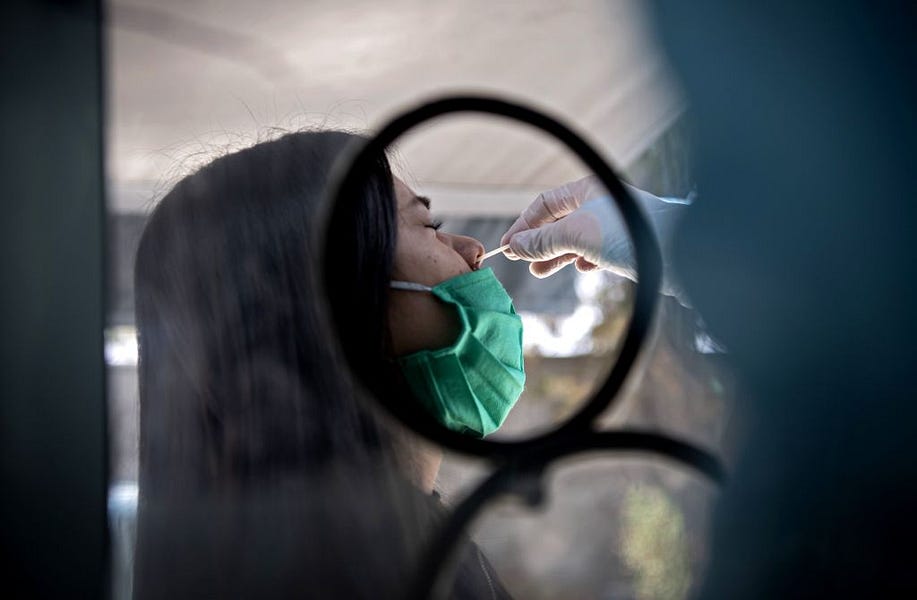In responding to a global pandemic, how do we balance the competing aims of preserving our health and minimizing disruptions to our lives and livelihoods? This remains the central question to every relevant policy debate six months in. This week, however, this debate has come to an unsettling new stage: a conversation over whether our testing itself has been conducted in an overly cautious way.
Most of us, when we think of them at all, think of a COVID test as a binary process: Someone sticks a cotton swab way too far up your nose or down your throat, and a few days later you find out if you have it.
But getting from Point A to Point B requires an elaborate laboratory process—a process that’s predicated on at least one injection of human subjectivity. The tests in ubiquitous use around the country make use of a process called polymerase chain reaction (PCR), which rapidly multiplies viral RNA in a sample to bring it to a measurable level. It’s a time-tested, proven process.
But it isn’t a one-step process: The PCR process must be cycled multiple times in order to get the virus to that level of visibility. How many cycles are necessary varies from test to test, but the math of exponential multiplication means that the more virus-saturated a sample was to begin with, the fewer you’ll need before you see the results.
The trouble—perhaps—involves how many times a test is cycled before it can be declared negative: up to either 37 or 40 cycles for COVID tests. In a New York Times article published over the weekend, a number of epidemiologists said they were concerned that the number of cycles was too high: enough to return a positive result even when truly miniscule amounts of the virus are present in the initial sample, “akin to finding a hair in a room long after a person has left.”
When tests are calibrated to be that sensitive, the argument goes, you might have a situation in which huge numbers of people are being told they are infected and must quarantine even when there’s seemingly not nearly enough virus in their system to pose a danger to themselves or anyone else.
If these doctors are right, and labs are running too many cycles on their COVID test samples, it would have enormous repercussions for how we track the pandemic. The Times followed up with several state labs to get access to their tests’ cycles data, and the results were stark: At New York’s state lab, about half of all positive tests would not have come back positive at all if they were cut off at 35 rather than 40 cycles.
So what gives here? Should labs adjust their protocols to be slightly less sensitive, running slightly fewer PCR cycles to avoid sweeping people with infinitesimal viral loads in with the rest of the infected?
Some experts argue it’s not that simple. The basic problem is that while a sample’s cycle threshold (or CT, the technical term for the number of cycles run before you hit paydirt) can roughly approximate the viral saturation of a sample, that doesn’t necessarily correspond to the viral load of the person being tested. Or to put it another way: Just because a swab picks up only a bit of virus from your sinuses, that doesn’t mean the bug’s not alive and kicking in the rest of your body.
“I get very concerned about making very sweeping statements about infectivity compared to CT value,” Dr. Susan Butler-Wu, a pathology professor and clinical microbiologist at USC, told The Dispatch. “These are specimens that are obtained from the upper respiratory tract. … And we know that over the course of time the virus actually transitions from being in your upper respiratory tract down into the lower respiratory tract, or your lungs. So I don’t think there’s really a whole lot of evidence at all to say that we know for sure that a high CT value means you’re definitely not infectious.”
Neither PCR tests nor the newer, less common antigen tests, several experts told The Dispatch, are really capable of determining whether a given person is contagious, offering only a foundation for general guesswork on that front. Further, even an extra-sensitive PCR test won’t find the coronavirus when no virus is there—meaning advocates for lowering PCR sensitivity could be playing with fire, raising the prospect for a testing change where a drop in “false” positives are balanced by a rise in false negatives.
In other words, it’s an argument a lot like every other coronavirus argument in these times: Which side do we want to err on?
“I think people want a black and white answer,” Dr. Butler-Wu said, “and there just isn’t one.”
Photograph by Martin Bernetti/AFP/Getty Images.






Please note that we at The Dispatch hold ourselves, our work, and our commenters to a higher standard than other places on the internet. We welcome comments that foster genuine debate or discussion—including comments critical of us or our work—but responses that include ad hominem attacks on fellow Dispatch members or are intended to stoke fear and anger may be moderated.
With your membership, you only have the ability to comment on The Morning Dispatch articles. Consider upgrading to join the conversation everywhere.